(part 1)
"Truth shall spring out of the earth" (Ps. 85:11).
Was There A Pre-Adamic Dinosaur World?
"Satan, which deceiveth the WHOLE world" (Rev. 12:9), has deceived many biologists and geologists. The "father" of all lies (John 8:44) is the true AUTHOR of the Theory of Evolution and the Geologic Column! A study of earth's geology does not teach LONG "geologic AGES." The VIOLENT currents and eddies of water of the SUDDEN pre-Adamic catastrophe swirled various types of soil and debris. This sediment quickly settled and solidified to form the strata we see today. The remains of animal and plant life are found within our earth's strata in a manner which only VIOLENT water action could have produced -- NOT gentle water action which would occur if the earth's surface GENTLY rose above the ocean level and then sank below it many times over millions of years as "uniformitarian" beliefs teach. Geology teaches a sudden catastrophic flood -- NOT what evolutionary geologists claim.
God tells man to prove His Word by ALL the things He has made -- by His Creation: "The invisible things of him from the creation of the world are CLEARLY SEEN, being UNDERSTOOD by the things that are MADE [God's Creation], even His eternal power and Godhead; SO THAT THEY ARE WITHOUT EXCUSE" (Rom. 1:20).
Did dinosaurs live on this earth prior to man's existence? Yes. The Scripture says that: "The earth BECAME without form and void; and darkness was upon the face of the deep" (Genesis 1:2 -- Lucifer's rebellion -- Isa. 14 & Ez. 28) before man arrived on the scene. This is the "Dinosaur World." The Dinosaurs became extinct prior to the creation of man (for the most part). There was a time gap between Genesis 1:1 and 1:2. The earth may have been created millions of years ago.
Man has been on this earth only about 6000 years, as proven by Biblical chronology and supported by the historical records of many nations (Ps. 104:29-30). God commanded man to replenish —or repopulate—the earth (Gen. 1:28). But we also find "living fossils" and even evidence of dinosaurs on earth in the last 6000 years. They weren't all destroyed in the flood "waters" of Genesis 1:1-2. Nor were they all destroyed in a later flood (1656 years later) in the time of Noah.
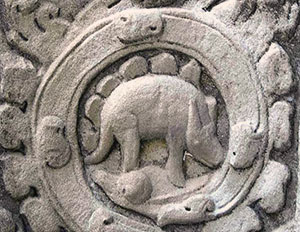
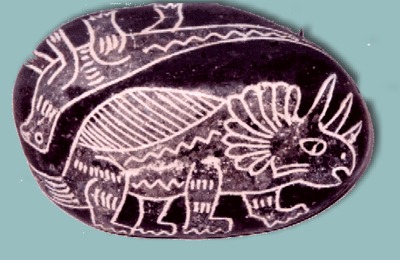
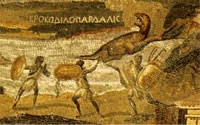
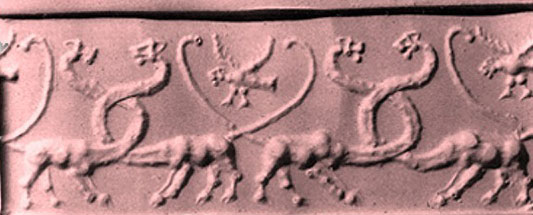
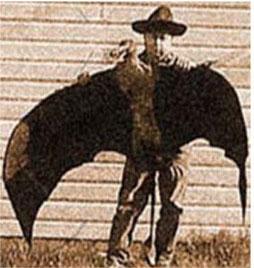
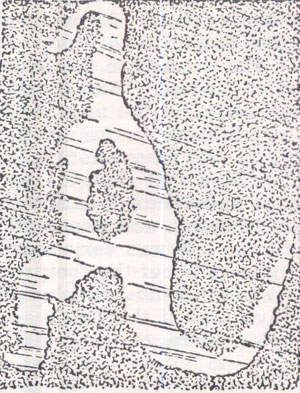


Have Humans Co-existed with Dragons?
Yes, humans and any surviving dinosaurs have co-existed. The Bible is clear that "all flesh died" outside the ark (Gen. 7:21) and only "they that were with him (Noah) in the ark" survived (7:23). Therefore, any dinosaurs that survived the dinosaur flood "waters" (Gen. 1:1-2) and then through Noah's flood must have either been aquatic (e.g. Nessie; Ogopogo) or eggs not yet hatched yet somehow preserved or Noah brought the reptiles on board the ark in a small baby form. Throughout human history, dinosaurs have been mentioned by the name "dragons" (English). The Nazca Indians of Ica, Peru (1 A.D. to 750 A.D.) produced Ica Stone burial carvings (16,000 discovered so far) portraying everyday life in that culture and of them about 500 portray DINOSAURS (see above). In Acambaro Mexico over 56,000 ancient clay figurines have been discovered that are various DINOSAURS. The approximate age is 4,500 years old. A dinosaur carving in Arizona's Hava Supai Canyon shown above. Herodotus described small flying reptiles that congregated in spice groves and frankincense trees in ancient Egypt and Arabia. They could have been the Pterodactyl called Ramphorhynchus since it had the same snake-like body and bat-like wings. The Greek philosopher Aristotle said these creatures existed in Ethiopia in his day. Strabo described similar three-foot-long animals in India. Pliny's Natural History of 70 A.D.said "Africa produces elephants, but it is India that produces the largest, as well as the DRAGON." Claudius Aelians who wrote De Natura Animalium in 200 A.D. said, "The Phrygian history also states that DRAGONS are born which reach ten paces in length." (30 feet) In 1271 A.D. Marco Polo recorded that the Chinese Emperor had DRAGONS that pulled his chariot on special occasions. About the Chinese province of Karzon, Polo records "Here are seen HUGE SERPENTS, ten paces in length, and ten spans in girth of the body. At the fore part, near the head, they have two short legs, having three claws like those of a tiger, with eyes larger than a forepenny loaf and very glaring. The jaws are wide enough to swallow a man, the teeth are large and sharp, and their whole appearance is so formidable that neither man, nor any kind of animal, can approach them without terror. Others are met with of a smaller size, being eight, six, or five paces long" (Travels of Marco Polo book 4, ch. 40). The Anglo-Saxon Chronicle of 793 A.D. reported, "This year came dreadful forewarnings over the land of the Northumbrians terrifying the people most woefully. These were immense sheets of light rushing through the air, and whirlwinds and FIERY DRAGONS FLYING across the firmament." (cp. Isa. 14:29; 30:6; Num.21:6; Deut. 8:15) Alexander the Great reported that when he conquered parts of India in 326 B.C., his soldiers were scared by GREAT DRAGONS that lived in caves. The book "Historia Animalium" claims that "DRAGONS were not extinct in the 1500s, but extremely rare and relatively small by then. The Plesiosaur (or Elasmisaur) are nocturnal and aquatic making them elusive to man, yet there are many credible accounts of human encounters with them even in modern times (Loch Ness monster; Ogopogo monster and Lake Champlain monster). "A twenty-foot serpent with a horse-shaped head and a body as thick as a keg" was the description given by Samuel De Champlain. "It looked like a huge serpent moving up and down not side to side like a fish. It was more than 30 feet long" was the description given by Dr. James Miller in his 1983 encounter. Eyewitnesses say the Loch Ness monster looks like a Plesiosaur. In a remote area of Cameroon, Africa, the locals describe encounters they have had with an aquatic, snake-like reptile about 30 feet long and reddish in color with sharp teeth and a ridge of scales down its back. It has been identified as a Sauropod called "Mokele-mbembe."
In Job 40:15-23 "behemoth" is described. "Behold now behemoth, which I made with thee; he eateth grass as an ox. Lo, now, his strength is in his loins, and his force is in the navel of his belly. He moveth his tail like a cedar. His bones are like strong pieces of brass; his bones are like bars of iron. He is the chief of the ways of God; he who made him can make his sword to approach unto him.... He lieth under the shady trees, in the covert of the reed, and fens (swamp) ... Behold, he drinketh up a river, and hasteneth not." Since this animal was created at the same time as man, we believe it is not a dinosaur, but rather a large mammal -- a hornless rhinocerous which stood 18 feet high and 27 feet long.
But in Job 41:1-34 "leviathan" is described. "Canst thou draw out leviathan with a fishhook? or tie down his tongue with a rope? Canst thou put an hook into his nose? or bore his jaw through with a thorn? Will he keep begging you for mercy? will he speak gentle words unto thee? Will he make a covenant with thee to take him as your slave for life? Wilt thou play with him as with a bird? or put him on a leash for your girls? Shall traders barter for him? Will they divide him up among the merchants? Canst thou fill his hide with harpoons? or his head with fish spears? If you lay a hand on him, you will remember the struggle and never do it again. Any hope of subduing him is false. The mere sight of him is overpowering. None is so fierce that dare stir him up: who then is able to stand before me? Who hath prevented (given to) me, that I should repay him? whatsoever is under the whole heaven is mine. I will not fail to speak of his limbs., his strength and his graceful form. Who can strip off his outer coat? Who would approach him with a bridle? Who dares open the doors of his mouth? his teeth are terrible round about. His back has rows of scales tightly sealed together. One is so near to another, that no air can come between them. They are joined one to another, they stick together, that they cannot be sundered. His snorting throws out flashes of light; his eyes arelike the rays of dawn. Out of his mouth go firebrands, and sparks of fire leap out. Out of his nostrils goeth smoke, as out of a seething pot or caldron. His breath kindleth coals, and a flame goeth out of his mouth (fire-breathing). In his neck resides strength, and dismay goes before him. The folds of his flesh are joined together: they are firm and immovable. His chest is hard as rock; yea, as hard as a piece of the lower millstone. When he raiseth up himself, the mighty are terrified: they retreat before his thrashing. The sword that reaches him has no effect: the spear, the dart, nor the javelin. Iron he treats like straw and bronze like rotten wood. Arrows do not make him flee; slingstones are turned with him into stubble. Darts are counted as stubble: he laugheth at the shaking of a spear. His undersides are jagged potsherds, leaving a trail in the mud like a threshing sledge. He maketh the deep to boil like a pot: he stirs up the sea like a pot of ointment. Behind him he leaves a glistening wake; one would think the deep had white hair. Nothing on earth is his equal -- a creature without fear He beholdeth all high things: he is a king over all the children of pride." This animal is probably the fire-breathing dragon (dinosaur) of "mythology" that actually did coexist with man for some time. The Dracorex skull fossil has a long muzzle and spikey horns and confirms this reality.
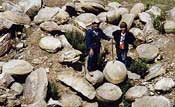
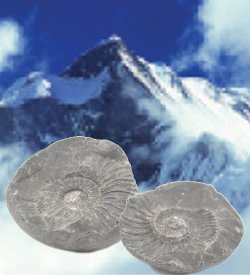
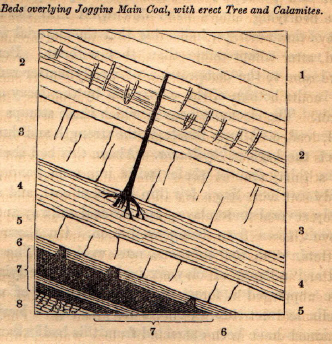
Did Noah's Flood Really Happen?
The EGYPTIANS had a legend that the gods at one time purified the earth by a great flood, from which only a few shepherds escaped. In the GREEK account, Deucalion was warned that the gods were going to drown the earth for its wickedness, so he built an ark which rested on Mt. Parnassus. A dove was sent out twice. In the HINDU tradition, Manu built a ship in which he alone escaped after being warned. In the CHINESE tradition, Fa-He escaped from a flood sent because man had rebelled against heaven. With his wife, three sons and three daughters he founded the Chinese civilization. POLYNESIANS say that 8 people escaped from a worldwide flood. MEXICANS, PERUVIANS, AMERICAN INDIANS and virtually every other ethnic people on earth have their own "flood legend." Such a universal belief must be based on historical fact. The Babylonian record we have was nearly all found in the Library of Ashurbanipal, long after Moses' record of Noah's Flood.
But as 2 Peter 3:3-6 says, "Knowing this first, that there shall come in the last days scoffers, walking after their own lusts, And saying, Where is the promise of his coming? for since the fathers fell asleep, all things continue as they were from the beginning of the creation (Uniformitarian belief). For this they willingly are ignorant of (evidence is overwhelming), that by the word of God the heavens were of old, and the earth standing out of the water and in the water, Whereby the world that then was, being overflowed with water, perished" (in Noah's flood).
What is the evidence of Noah's Flood? Over 500 giant, fossilized oysters (12 feet wide and up to 650 pounds each) have been found about two miles above sea level in the Andes mountains of Peru in January 2001 by Arturo Vildozola near the town of Acostambo. This demonstrates the fact that at one time these mountains were under water as would have happened in Noah's worldwide flood since such bi-valve mollusks are ocean-dwelling (see picture above). Fossil ammonites (coiled marine cephalopods) found in limestone beds high in Nepal's Himalayas (see picture above). How did marine fossils get thousands of feet above sea level? Polystrata fossils demonstrate that sediment layers were deposited rapidly, not over long ages (see picture above). In January 1967, the Aluminaut, the world's deepest diving submarine, at that time, discovered an undersea road off the coast of Florida, Georgia, and South Carolina. The road extended to depths of 3000 feet and was paved with a layer of magnesium oxide. It is still in good condition many thousands of years after it was constructed. In 1966 during a research expedition led by Dr. Robert J. Menzies of Duke University, the expedition photographed what appeared to be carved rock columns under 6000 feet of ocean in what is called the Milne-Edward Deep. Dr. Menzies admitted that it may be the ruins of an ancient city. Many columns appeared to have some kind of writing on them. A salvage crew aboard the ship Talia from Spain videotaped miles of pillared temples, buildings and statues and wide curving boulevards with smaller avenues branching out from the center like spokes in a wheel in the Atlantic. Another ancient city one half mile down off the west coast of Cuba was found by a team of Canadian and Cuban researchers. Structures like those at Stonehenge and Easter Island were found. But some of the structures were over 1,300 feetwide and over 130 feet high and some of them sit on top of eachother. They all show very distinct shapes and symmetrical designs of a non-natural kind. Photos clearly show symbols and inscriptions, but the language is unknown.
Local fishermen in Mahabalipuraman, southern India have believed for centuries that a great flood consumed a city in a single day. Nobody believed them, until one researcher, Graham Hancock, finally took them seriously. He and a team checked out their story in 2002 and found an extensive area of submerged structures that were clearly man-made. In fact, the scale of the ruins covers several square miles and they are as spectacular as the ruined cities submerged off of Alexandrian Egypt. If the dating holds true, it would totally upset previous archaeological opinion because archaeologists don't recognize any culture in India capable of building anything like this during that time. Hancock himself says scientists should be more open-minded: "I have argued for many years that the world's flood myths deserve to be taken seriously, a view that most western academics reject. But here we have proven the myths right and the academics wrong." In 1987 an underwater city was discovered off the coast of Japan. Known as Yona Guni, there are stone megaliths and ceremonial structures over 500 feet long and taller than an 8 story building. A large human head is carved in rock about ten times size. It is an archaeological fact that there are more than 200 known sunken cities in the Mediterranean.
The flood waters left huge marks on the earth. The erosive powers of receding flood waters completed the gouging of the Grand Canyon of western United States. And the churning, powerful waters laden with sediment, buried billions of animals and plants! Their remains have been found around the world -- mute testimony of the great destruction brought on the earth because of man's sins.The theory of evolution would have people believe that these creatures were gradually buried over millions of years.
Yet any geologist must admit that an animal must be buried fairly quickly by sediment, or other means, or his skeleton will not become a fossil. Millions of bison were killed on the Great Plains in the United States in the last century, yet not one became a fossil. A vivid example that a gigantic flood had to bury the billions of creatures scientists find entombed in the rocks!
All the flood deposits of Noah's time are thin and scattered over the surface of the earth. Geologists call these deposits "Cenozoic."
At the foot of Mount Ararat sits the ancient city of Naxuana, or Nakhichevan. It claims the tomb of Noah. And its name, translated, means: "Here Noah settled."
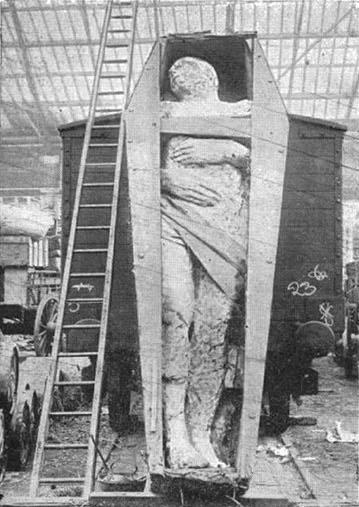
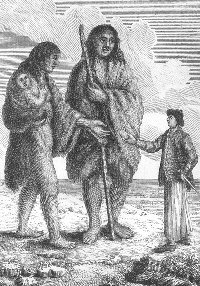
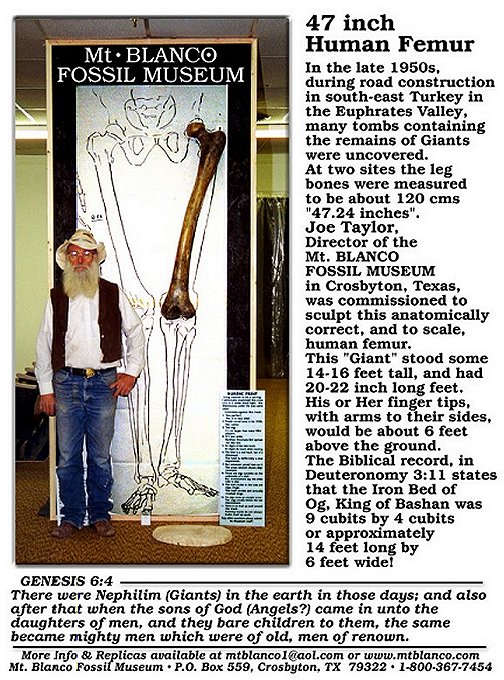

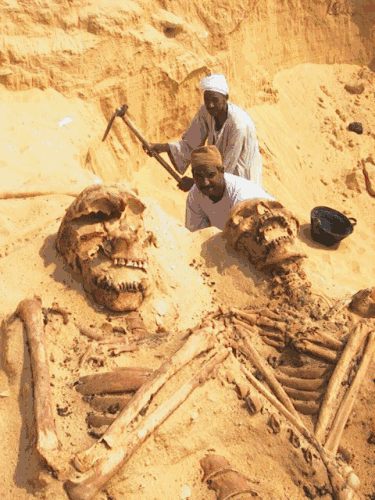
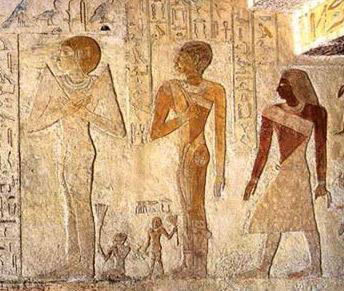
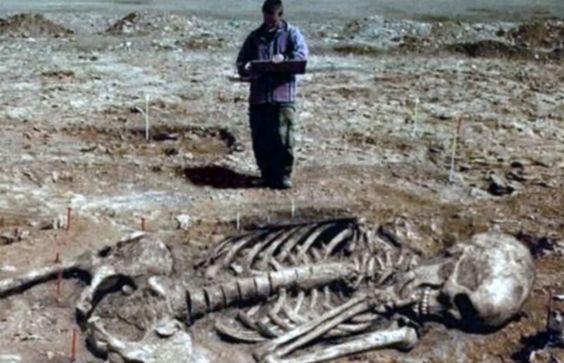
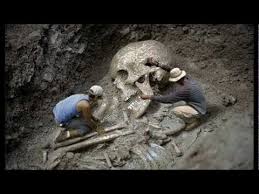
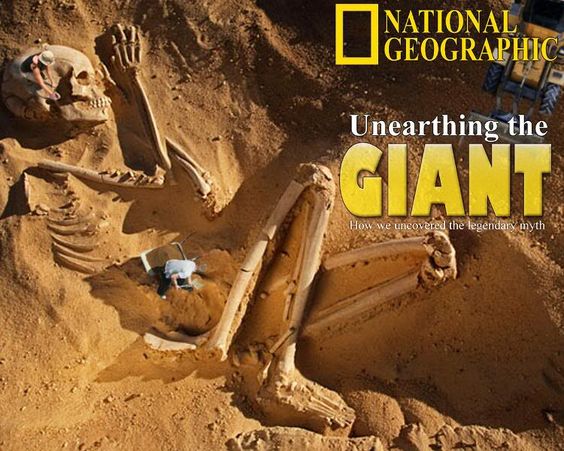
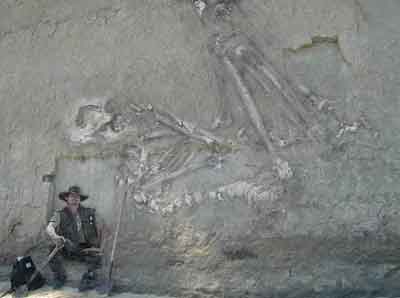
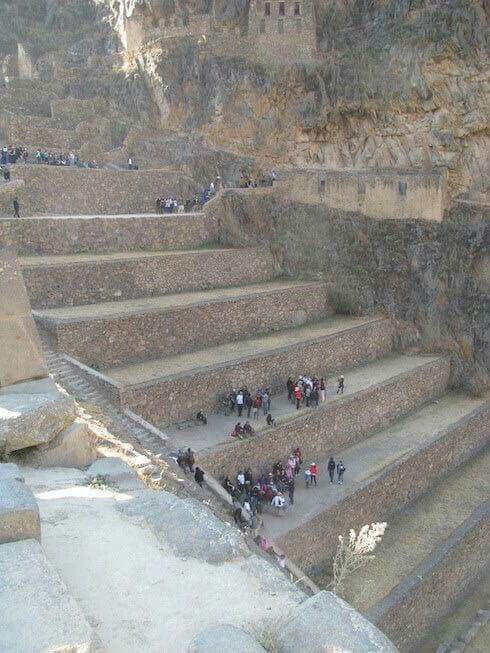
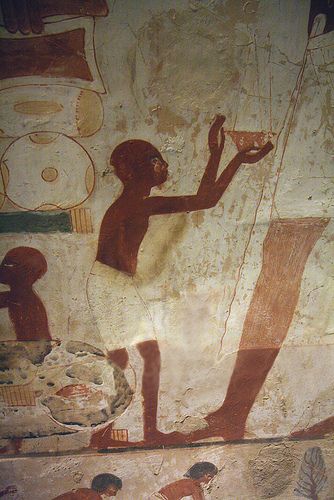
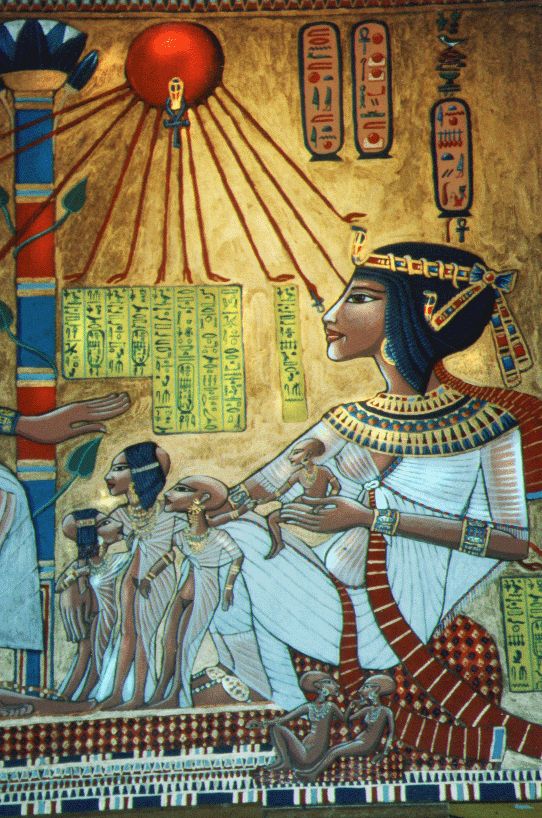
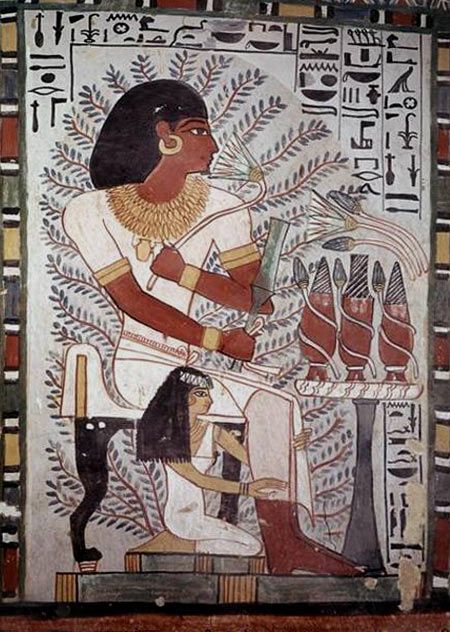

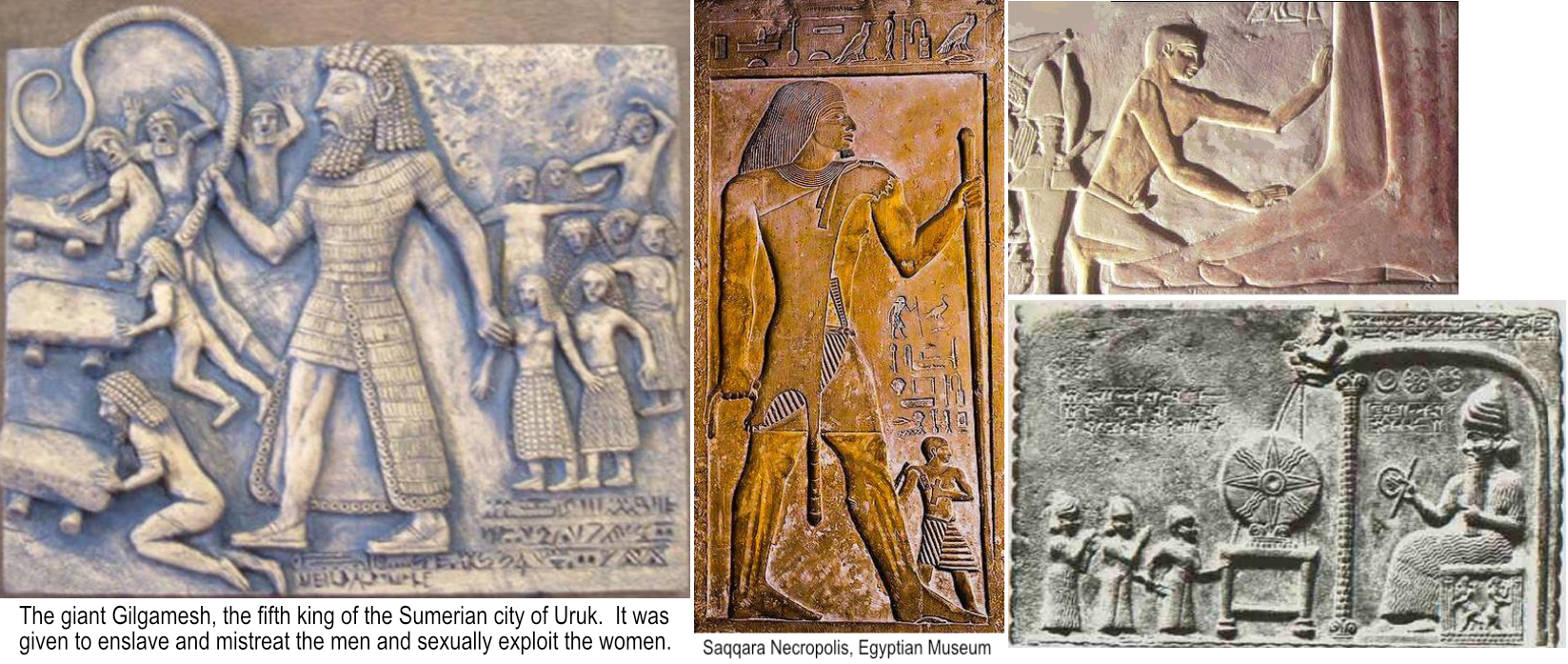
"There Were Giants in Those Days ..."
Not just human giants, but animals, fish and birds grew to giant size. Plants and insects also. Giant reptiles, some more than 100 feet long. Dragonflies with 36" wingspan. Sixty-foot cattails. Fossil ferns have been discovered the size of trees and horsetails once towered over thirty feet tall. The skull of a giant "extinct" beaver currently exhibited at the St Louis Science Center proves that beavers were once 8 feet long--as large as a modern black bear. The Irish elk is also known as the giant deer (Megaloceros giganteus). Its well-preserved remains are often found in lake sediments under peat bogs in Ireland. It stood seven feet tall at its shoulder. Adult males had massive antlers that spanned 12 feet and weighed up to 88 pounds. Researchers from Basel and Zurich Universities have found camel bone fragments in Syria near the village of El Kowm, from the foot, shoulder and jaw that are all around twice the normal size for a camel. The giant camel stood about thirteen feet tall. Giant hornless rhinoceros which stood 18 feet high and 27 feet long. The giant catfish found in Thailand(Pla Buek in Thai) can weigh as much as 650 pounds (300 kilograms) and measure up to 10 feet (3 meters) in length. They are the largest scaleless freshwater fish in the world.Discovered by two paleontology students in clay pits near Peterborough, England, the fossil is the largest known fish ever recorded. Leedsichthys problematicus is the biggest fish known to science. It is 72 feet in length, almost twice as long as the whale shark, the biggest fish in the ocean today. The twenty-five foot wingspan of Argentavis Magnificens is displayed at the Natural History Museum in Los Angeles. The feather size from such a bird is estimated to have been 60 inches long and 8 inches wide. An armadillo the size of a Volkswagon unearthed in Cuzco, Peru. In 1991, alligator bones were found on the banks of the Amazon River. The skull was almost 5 feet long. Based on this, scientists estimated its height to have been 8 feet (when walking) and its length 40 feet (the size of a railroad boxcar) (see "super croc" from National Geographic). Alligators grow at a rate of about 20 feet per hundred years. A giant turtle about 15 feet long was seen by the crew of the fishing boat Rhapsody off the coast of Nova Scotia in May 1956.(Walter Molino in La Domenica del Corriere, 24 June 1956, Fortean Times). Six-foot long centipedes. Eight-foot long rollypolly bugs. Pigs grew to be as large as cattle. Huge rodents like the giant guinea pig grew as big as a modern rhinoceros. Ground sloths 18 feet long. There were cockroaches about two feet long, as well as crickets, grasshoppers and monstrous spiders. Over 500 giant, fossilized oysters (12 feet wide and up to 650 pounds each) have been found about two miles above sea level in the Andes mountains of Peru in January 2001 by Arturo Vildozola near the town of Acostambo. This demonstrates the fact that at one time these mountains were under water as would have happened in Noah's worldwide flood since such bi-valve mollusks are ocean-dwelling. The Bible teaches us that before the flood, men lived over 900 years old. If men lived that long, why wouldn't animals? If they did live that long, a reptile has the potential of growing throughout its life. Unlike other animals, a reptile has no "cutoff" mechanism to keep it from growing in size. Prior to the flood, a vapor canopy covered the earth which blocked out harmful UV radiation which gets through today causing accellerated aging. The canopy would have also created an almost perfect year-round temperature, like living in a greenhouse. Carl Baugh, a creation scientist of Glen Rose Texas, designed a biosphere which mimics the pre-flood atmosphere. He doubled the atmospheric pressure; increased the electro-magnetic energy; increased the ratio of oxygen but not to the level of toxicity; and eliminated ultra-violet radiation among other things and found that his pirahna fish grew to gigantic sizes. Where do these giants fit into the fictitious geologic column? Where do they fit in the fictitious Theory of Evolution?
What does the Bible say about human giants? "There were giants (#5303: nephillim -- from the root "to fall" -- "fallen ones") in the earth in those days (angels had sex with humans pre-flood); and also after that (angels had sex with humans post-flood), when the sons of God (always refers to angels in O.T.: Job 1:6; 2:1; Job 38:7; Dan. 3:25. This is the view taken by Josephus, Philo Judæus, and the authors of “The Book of Enoch” and “The Testament of the Twelve Patriarchs”) came in unto the daughters of men, and they bare [children] to them, the same [became] mighty men which [were] of old, men of renown" (Gen 6:42) or "famous" by means of the Greek legends where Titans were the offspring of mortals and immortals. The Titans rebelled against their father Uranus and were defeated by Zeus and condemned to Tartarus. Egyptian bas reliefs portray seated giants that appear to be over 18 feet tall (see picture above). Modern accounts of "alien abductions" therefore may be one fulfillment of "As in the days of Noah were, so shall the coming of the Son of Man be" and "they shall mingle themselves with the seed of men" (Dan. 2).
In a battle which took place at Gath, there was a huge man with six fingers on each hand and six toes on each foot--twenty-four in all. He also was descended from Rapha. When he taunted Israel, Jonathan son of Shimeah, David's brother, killed him (2 Samuel 21:15-22). Numbers 13:33 says, "And there we saw the giants (#5303: nephillim -- "fallen ones"), the sons of Anak, which come of the giants [#5303: "fallen ones" -- "angels that sinned" The angel spirits lusted after women who were "strange flesh" because human -- 2 Pet. 2:4; Jude 6, 14 quoted from 1 Enoch 1:95. The angels disrobed themselves of their spiritual body proper and materialized into earthly bodies for the word used is "oikeeteerion" which elsewhere means the opposite process of being clothed with a heavenly body (2 Cor. v. 2). Even the very act of marriage was wrong since our Lord tells us that, in their normal condition, angels “neither marry,” nor are given in marriage (Matt. 22:30)] and we were in our own sight as grasshoppers, and so we were in their sight." Deuteronomy 2:11 says "Which also were accounted giants (#7497: raphah -- "invigorating") , as the Anakims; but the Moabites called them Emims." Deuteronomy 2:20 says, "(That also was accounted a land of giants (#7497: raphah -- "invigorating"): giants dwelt therein in old time; and the Ammonites call them Zamzummims"; Deuteronomy 3:11 says, "For only Og king of Bashan remained of the remnant of giants (#7497: raphah -- "invigorating"); behold his bedstead was a bedstead of iron; is it not in Rabbath of the children of Ammon? nine cubits was the length thereof (13.5 feet), and four cubits the breadth of it, after the cubit of a man." Deuteronomy 3:13 says, "And the rest of Gilead, and all Bashan, being the kingdom of Og, gave I unto the half tribe of Manasseh; all the region of Argob, with all Bashan, which was called the land of giants" (#7497: raphah -- "invigorating").
Do we have any archaeological proof of giant men who were approximately 12 to 13 feet tall? The British Strand magazine of December 1895, reprinted in W. G. Wood-Martin's Book, Traces of the Elder Faiths of Ireland, mentions a fossilized giant (pictured top left) that had been found during mining operations in County Antrim, Ireland: "Pre-eminent among the most extraordinary articles ever held by a railway company is the fossilized Irish giant, which is at this moment lying at the London and North-Western Railway Company's Broad street goods depot, and a photograph of which is reproduced here...This monstrous figure is reputed to have been dug up by a Mr. Dyer whilst prospecting for iron ore in County Antrim.The principal measurements are: entire length, 12 ft 2 in.; girth of chest, 6 ft 6 in.; and length of arms, 4 ft 6 in. There are six toes on the right foot. The gross weight is 2 tons 15 cwt.; so that it took half a dozen men and a powerful crane to place this article of lost property in position for the Strand magazine artist. Dyer, after showing the giant in Dublin, came to England with his queer find and exhibited it in Liverpool and Manchester at sixpence a head, attracting scientific men as well as gaping sightseers. Business increased and the showman induced a man named Kershaw to purchase a share in the concern. In 1876, Dyer sent this giant from Manchester to London by rail; the sum of 4 2s 6d being charged for carriage by the company, but never paid. Evidently Kershaw knew nothing of the removal of the 'show', for when he discovered it he followed in hot haste, and, through a firm of London solicitors, moved the Court of Chancery to issue an order restraining the company from parting with the giant, until the action between Dyer and himself to determine the ownership was disposed of. The action was never brought to an issue. Unfortunately (as far as this writer knows), nothing more was ever heard of the Antrim giant or its owners."
"While we were in the sandhills, scouting the Niobrara country, the Pawnee Indians brought into camp some very large bones, one of which the surgeon of the expedition pronounced to be the the thigh bone of a human being. The Indians said the bones were those of a race of people who long ago had lived in that country. They said these people were THREE TIMES the size of a man of the present day, that they were so swift and strong that they could run by the side of a buffalo, and, taking the animal in one arm, could tear off a leg and eat it as they ran." (Colonel William F. Cody, 1920)
In July, 1877, four prospectors were looking for gold and silver outcroppings in a desolate, hilly area near the head of Spring Valley, not far from Eureka, Nevada. Scanning the rocks, one of the men spotted something peculiar projecting from a high ledge. Climbing up to get a better look, the prospector was surprised to find a human legbone and knee cap sticking out of solid rock. He called to his companions, and together they dislodged the oddity with picks. Realizing they had a most unusual find, the men brought it into Eureka, where it was placed on display. The stone in which the bones were embedded was a hard, dark red quartzite, and the bones themselves were almost black with carbonization - indicative of great age. When the surrounding stone was carefully chipped away, the specimen was found to be composed of a leg bone broken off four inches above the knee, the knee cap and joint, the lower leg bones, and the complete bones of the foot. Several medical doctors examined the remains, and were convinced that anatomically they had indeed once belonged to a human being, and a very modern-looking one. But an intriguing aspect of the bones was their size: from knee to heel they measured 39 inches. Their owner in life had thus stood over 12 feet tall. Compounding the mystery further was the fact that the rock in which the bones were found was dated geologically to he era of the dinosaurs, the Jurassic - over 185 million years old. The local papers ran several stories on the marvelous find, and two museums sent investigators to see if any more of the skeleton could be located. Unfortunately, nothing else but the leg and foot existed in the rock." Strange Relics from the Depths of the Earth--Jochmans
A mound near Toledo, Ohio, held 20 skeletons, seated and facing east with jaws and teeth "twice as large as those of present day people," and besides each was a large bowl with "curiously wrought hieroglyphic figures." (Chicago Record, Oct. 24, 1895; cited by Ron G. Dobbins, NEARA Journal, v13, fall 1978)
The first Europeans to sail along the patagonian costs were Ferdinand of Magallanes and his crew in 1520. Their first meeting with the aborigins (Tehuelches) was recorded by Antonio Pigafetta, the chronicler of the expedition, in a by now famous passage: "One day, when no one was expecting it, we saw a giant, completely naked, by the sea. He danced and jumped and, singing, spread sand and dust over his head...He was so tall that the tallest among us reached only to his waist. He was truly well built...The captain named these kind of people Pataghoni (top center drawing). They have no houses but huts, like the Egyptians. They live on raw meat and eat a kind of sweet root which they call capac. The two giants we had on board ship ate their way through a large basket of biscuits, and ate rats without skinning them. They used to drink a half bucket of water at once." It is a common belief that the name Patagons alluded to the apparently outstanding foot size of the Tehuelches.
Hazleton Pennsylvania Sentinel, August 1881: About three miles from Ashley, a Mr. McCauley has the contract from the Wilkes-Barre Coal & Iron Co. for sinking a coal shaft. It is twenty feet square and is intended to have two tracks for carriages to run in hoisting up the coal, and is said to be the largest opening of the kind in the coal regions. It is located near the base of the mountain and has reached a depth of 475 feet. Saturday last, when the gang, or what is known as the second shift of men, were about retiring, after firing off a course of holes, Tom Cassidy, the foreman, descended the shaft to ascertain the result of the explosion, and was astonished to find an immense cavity in one of the sides of the shaft. The explosion appeared to have a terrible effect and caused more damage than benefit on one side, but his astonishment was still greater increased on clearing away some of the refuse of the rock blown by the shots to discover a solid mass of rock in which appears a clearly-defined human shape of giant proportions. All the limbs, muscles and linaments are apparent. The rock is about 16 feet in length, 18 in breadth, and about 8 in thickness. The dimensions of the human frame are giantly, measuring 12 feet in length and 4 feet across the chest. Across the breast is the impression of a huge shield, about four feet in circumference, while the right hand clutches the broken and butt end of a large cutlass or sword. The rock was taken out whole and is now in possession of Mr. McCauley in Ashley.
Moses mentions the strong cities of Bashan, and speaks of their high walls and gate and that Bashan was called the land of the giants (or Rephaim, Deut. 3:13). We can conclude that these megalithic cities were built by giants therefore. The houses of Kerioth and other towns in Bashan appear to be just the kind of dwellings a race of giants would build. One door in Kerioth was nine feet high, four and a half feet wide, and ten inches thick, made from one solid slab of stone. The folding gates of another town in the mountains were still larger and heavier. The heavy stone slabs of the roofs resting on the massive walls make the structure as firm as if built of solid masonry; and the black basalt used is almost as hard as iron. There can scarcely be a doubt, therefore, that these are the very cities erected and inhabited by the Rephaim, the aboriginal occupants of Bashan. Gilgamesh is portrayed as holding a lion in an ancient bas relief (upper left).
Saxo Grammaticus, Denmark's first historian, tells us that the giant known as Hartebenunf was thirteen and a half feet high and that he had twelve companions, who were each 28 feet tall. The French nobleman Scory, in his journey to the peak of Teneriffc, says that they found in one of the caves of that mountain the head of a mummy which had eighty teeth and that the body was not less than fifteen feet long. A 16th century anatomist, Reviand who spent his spare time dissecting human bodies collected from graveyards and executions, claimed in 1614 that in the suburbs of St. Germane, that there was a tomb holding the bones of the giant Isoret and that his height was 20 feet. At Rouen, France in the year 1509, while digging ditches, the remains of a giant were reportedly found in a tomb, whose shin bone reached to the top of the girdle of every man there, making them about four feet tall, corresponding to a man some 17 or 18 feet tall. There was reportedly an inscription on a copper plate affixed to the tomb reading; "In this tomb lies the noble and puissant lord, the Chevalier Ruon de Vallemont and his bones." A number of museums of Europe perhaps still have in their basements or warehouses huge suits of armor and or double handed swords and other implements that might serve to support stories of giant swordsmen. Near Margariao, In Sicily, in 1516, was found a giant thirty feet high. His head was the size -of a hogshead, and each of his teeth weighed five ounces. Near Palermo, in the valley of Magara, in Sicily, a skeleton of a giant thirty feet long was found in the year 1545 and another thirty-three feet high in 1550. Several of the gigantic bones of the latter subject are still preserved by private persons in Italy. (The Altoona Mirror, May 1905). A skeleton found in a riverbank not to far from Calcutta, India measured 31 feet. (New Castle PA. News, August 9, 1934). The leg bones alone it was reported measured ten feet. It was reported that the skeleton was believed to be human and was evidence that a giant race had once existed. It reportedly took three men to remove the skeletal remains to a nearby palace where it awaited examination by anthropologists.

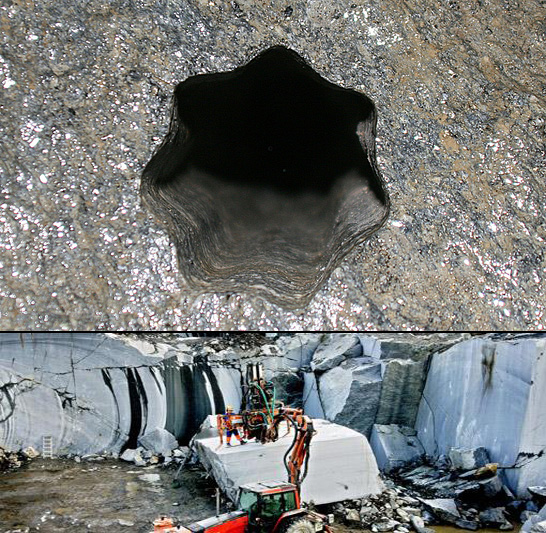
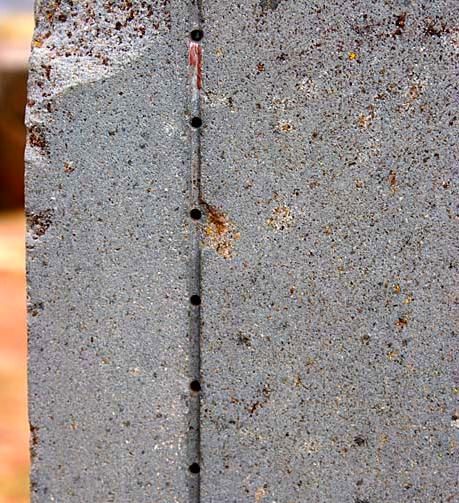
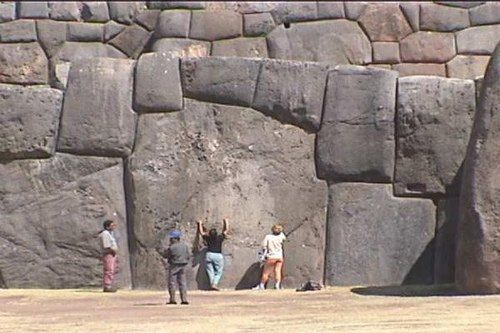
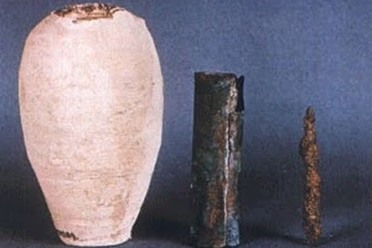
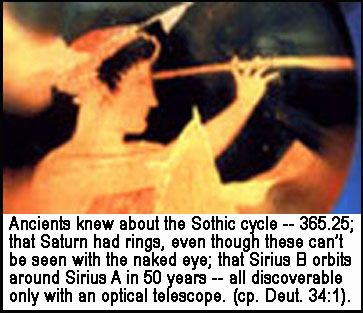
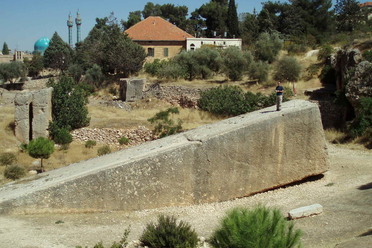
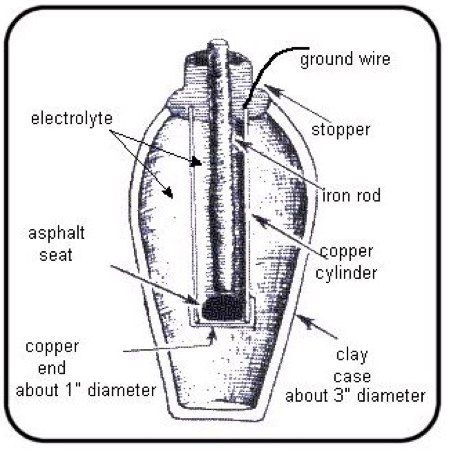
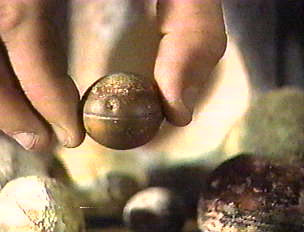

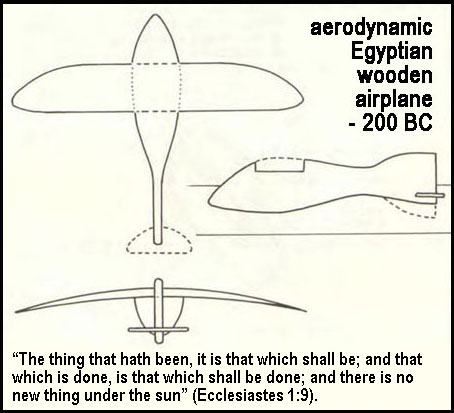
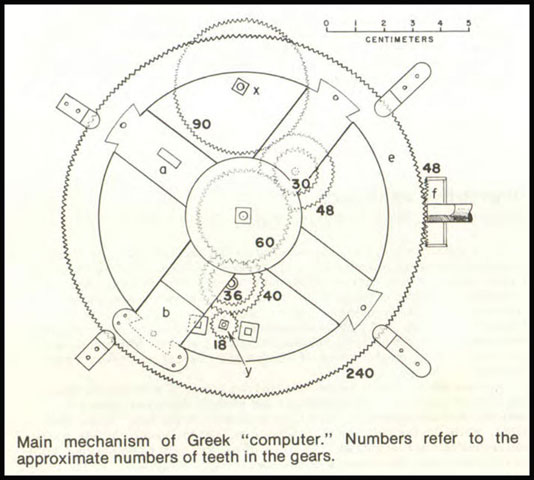

"Now Nothing Will Be Withheld From Them, Which They Have Imagined to Do" (Gen. 11:6)
Was the post-flood world on the verge of a knowledge explosion? Was there a highly technical society soon after Noah's flood?
(1.) In 1908 sponge divers discovered an ancient mechanical computer marvel called the Antikythera Mechanism (upper left reconstructed). More complicated than a modern swiss watch, it was a virtual planetarium. Created in 70 B.C., it accurately predicts the position of the sun and moon for each day of the year; the phase of the moon at any given time; and the eclipses of sun and moon. It also traces the path of certain planets. Cicero mentions this device. (2.) We know of over a dozen 4000-year-old Baghdad batteries which only needed to be filled with electrolyte such as lemon juice or vinegar in order to produce current (upper middle). Each battery consisted of a clay jar holding a hollow copper cylinder in which was positioned an iron rod. Bitumen remains were found on the top and bottom of the copper cylinder used to hold the iron rod in place. When a modern researcher, Jason Martell, did an on-camera experiment for Discovery Channel that duplicated these elements and added lemon juice, he consistently generated 4 volts. Such a device could have also been used for electro-plating. Three in series would have produced the standard 12 volts of today that can power so many devices. (3.) Tombs and recesses and dark crypts all over Egypt have intricate painted hieroglyphics covering all walls and ceiling. However, there is no evidence of flame; no burning carbon; no soot. How did Egyptians see inside these dark recesses? Copper reflective mirrors can only reflect so far down the hall or shaft, so an alternate theory is that they employed electricity. In one hieroglyph they clearly holding what looks like a light bulb that has a cord plugged into some device. The bulb clearly has two wires inside that may be the filament.(4.) An ancient spark plug was found in California in 1961 by men collecting geodes. But when they cut this "geode" open, they found an object inside which was made of a porcelain-like material, and in the center of it was a shaft of shiny metal. The porcelain material was surrounded by a hexagonal casing and later an X-ray revealed a tiny spring at one end, just like a modern-day spark plug. But encased inside a 500,000 year old rock. (5.)The ancient people of the Columbian Rain Forest created gold insect-like carved trinkets which were discovered in 1965. They were not insect replicas. The wings were placed at the bottom of the body unlike all insects. These were delta-shaped front wings as well as rear wings. A vertical stabilizer and rudder are clearly shown (upper middle). Aelerons also are present. Although it is impossible to date gold objects, their estimated creation took place between 500 to 600 A.D. Peter Belting's larger model plane built to scale actually proved that this "plane" could fly. It was radio controlled. In a tomb in Saqquara, Egypt, a wooden plane model has been found dating from 200 B.C. that also indicates ancient human flight. (6.) The Piri Reis Map, named after the Turkish admiral who copied it in 1513 onto a gazelle skin from many ancient sources back as far as the 4th century B.C., gives the accurate topography and coastline shape of Antarctica. Yet today the Antarctic "Queen Maud Land" is under a layer of ice over a mile thick. Geologic evidence confirms that the latest date this continent could have been charted in an ice-free state is 4000 B.C. Ground-penetrating radar is needed today to achieve the same result. Another similar map, called the Finaeus Map, also gives an accurate topography of Antarctica. (7.) Stone megalithic monuments all over the world demonstrate an ability to move and shape stone that requires advanced technology. The stones are made to fit perfectly together. Stones are designed with keyways for two adjoining rocks so that molten metal can be poured into them and permanently attach them using an "H"- pattern bracket. There are symmetrically-drilled holes throughout the stone. This all implies diamond grinding wheels and diamond-tipped drills. At Baalbek, Lebanon, the main foundation platform is composed of the largest hewn rocks in the world, the famous ashlars of Baalbek. Some of the individual stone blocks are 82 feet long and 15 feet thick and are estimated to weigh between 1,200 and 1,500 tons each! Also 100,000-ton rocks were lifted and moved -- somehow. Of course 15-foot giant men as well as giant quadraped animals such as the hornless rhinoceros which stood 18 feet high and 27 feet long would certainly make the task easier than it would be for the 6-foot tall humans of today, but that still doesn't fully explain how they did it. (8.) Ancient springs were found by gold miners in the Ural Mountains that are 1/10,000 of an inch. (9.) Museums all over the world contain ancient ground optical lenses that generally magnify about 1.5 or 2 times. They are made of rock crystal, not glass. Heinrich Schliemann, the 19th century discoverer of Troy, excavated 48 rock crystal lenses at Troy which are now in Moscow. Another large number of crystal lenses exist in Crete, mostly found at Knossos. Concave lenses used to correct myopia (shortsightedness) can be found at Ephesus, in Turkey, some reducing images as much as 75%. Most ancient lenses are convex and were used to magnify. At Carthage there are 14 glass lenses and two of rock crystal stored in a drawer in the museum -- not on display. One pair of glass lenses was excavated from mummy wrappings in Egypt and obviously were used as spectacles except that there were no loops to attach around the ears. An ivory knife handle was excavated in the 1990s from a predynastic grave of that date at Abydos in Egypt. It belonged to a king and dates to 3300 BC. It bears microscopic carvings which could only have been made with, and can only be seen with, a magnifying glass. The oldest actual lenses which I have found are from the 4th and 5th Dynasties of ancient Egypt and date to perhaps 2500 BC. These are perfectly ground and polished convex crystal lenses which are used as eyes in statues of that date. One such statue is in the Louvre, in Paris, but the rest are in the Egyptian Museum in Cairo. Many ancient classical texts describe both magnification and works produced under magnification by craftsmen. For instance, Seneca, the Roman philosopher, wrote about filling transparent vessels with water in order to magnify objects seen through them, and Cicero, Pliny and others described microscopic works of art. (see The Crystal Sun by Robert Temple). Cicero's miniature version of the Iliad could fit inside a walnut shell. Hence, 'in a nutshell', came into use via Shakespeare's Hamlet. In the throne room of the Assyrian King Sargon II's palace in Iraq was found the Layard Lens now in the British Museum. It dates to the 8th century BC and was a convex toroidal-ground lens with a flat ('plane') base to correct for astigmatism and used as a monocle. More than a hundred lenses survive in Sweden and the surrounding countries from eastern Viking technology. None, however, are known from western Vikings of Norway. The Eastern Vikings were grinding and polishing lenses the size of rain drops which could magnify three times. There are many old British lenses as well. Some have projecting points at the back so both hands of a craftsman are free to work while the magnifier stands on its own. At Troy, one crystal lens had a hole drilled through its center, allowing the craftsman to insert his carving tool, while the magnification all around was undisturbed. Ancient telescopes were not a difficult invention once they had the lenses. All you have to do is to hold up a lens in each hand and look through them both at once: thus you have a rudimentary telescope. Even though the image is inverted - it takes a third lens to flip it right way up - this makes no difference if you are, for instance, studying the surface of the moon or looking at the stars. No one can tell if a star is right way up or upside down - it all looks the same.
What Does Secular History Say About Nimrod?
Merodach is one name for Nimrod. The same root "mered" (to rebel) is in both. "Ninus" means "Son." "Ninus is Nimrod" (Apollodorus frag. 68). The Bible says Nimrod "began to be a mighty one in the earth" (Gen. 10:8). What does this mean? "Ninus, king of the Assyrians, first of all changed the contented moderation of the ancient manners, incited by a new passion, the desire of conquest. He was the first who carried on war against his neighbors, and he conquered all nations from Assyria to Lybia, as they were yet unacquainted with the arts of war" (Justin's Trogus Pompeius, Hist. Rom. Script.2:615). Diodorus Siculus adds, "Ninus, the most ancient of the Assyrian kings mentioned in history, performed great actions. Being naturally of a warlike disposition, and ambitious of glory that results from valour, he armed a considerable number of young men that were brave and vigorous like himself, trained them up a long time in laborious exercises and hardships, and by that means accustomed them to bear the fatigues of war, and to face dangers with intrepidity" (Diodorus Bibliotheca 2:63). The beginning of his kingdom was Babel" (Gen. 10:10). A beginning implies something later, not a competitor known as Asshur who also built four cities. Genesis 10:11 should read, "out of that land he (Nimrod) went forth, being made strong, and builded Nineveh, and the city Rehoboth, and Calah." "Asshur" is the passive participle of a verb which, in its Chaldee sense, signifies "made strong." It is not a proper name. This now agrees with Justin: "Ninus strengthened the greatness of his acquired dominion by continued possession. Having subdued, therefore, his neighbors, when, by the accession of forces, being still further strengthened, he went forth against other tribes, and every new victory paved the way for another, he subdued all the peoples of the East" (Justin Hist. Rom. Script. 2:615). Nineveh means "the habitation of Ninus." Also the name of the chief part of the ruins of Nineveh is Nimroud today (Layard's Nineveh and Its Remains 1:7). Since Ninus is said to be the son of Belus or Bel, and Bel is said to have founded Babylon, we know Bel was Cush for "Cush begat Nimrod" (Gen. 10:8). "Bel is confounded" (Jer. 50:2) alludes to the fact that Bel meant "the Confounder" just as in the Chaldee pronunciation, "Chaos" is one way to pronounce "Cush." Janus said "the ancients ... called me Chaos" (Ovid's Fasti 1:104). The club of Janus in Chaldee is called "hephaitz," the same word for "scattered abroad" in Genesis 11:9. Since Hermes is an Egyptian synonym for the son of Ham (Her means "burnt one" and mes means "son" in Chaldee), we know Cush was Hermes or Mercury. "For many ages men lived under the government of Jove (Jehovah), without cities and without laws, and all speaking one language. But after that Mercury interpreted (Peresh in Chaldee can also mean "divided") the speeches of men (interpreting is called hermeneutics), the same individual distributed the nations. Then discord began" (Hyginus Fab. 143:114). An ancient tablet recovered in recent years from the ruins of a tower located in the center of old Babylon seems to confirm the Tower of Babel incident. Found by G. Smith, it contained this fateful report: "The building of this illustrious tower offended the gods. In a night they threw down what they had built. They scattered them abroad, and made strange their speech."
Did Serug, Nahor and Terah Really Exist?
The patriarchs' original homeland was in south-central Turkey, in an area known as Aram Naharaim (Gen. 24:10) or Padan-Aram (25:20). Serug's name corresponds to the place called Sargi in Assyrian inscriptions of the seventh century B.C. and today is called Suruc, 35 miles northwest of Haran. A town called Nahor is mentioned in texts from Mari and Cappadocia from the nineteenth through eighteenth centuries B.C., as well as in Assyrian inscriptions from the fourteenth century B.C. Later Assyrian records from the seventh century B.C. refer to it as Til Nakhiri which means "Mound of Nahor." A town named Til Turahi ("Mound of Terah") is mentioned in the ninth century Assyrian texts as being north of Haran.
What Proof Do We Have Of Sodom & Gomorrah?
The shallow south end of the Dead Sea is considered by many to be the site of ancient Sodom and Gomorrah. "Slime" (Gen.14:10) was bitumen, asphalt, pitch, a lustrous black petroleum product, which MELTS and BURNS. There are large beds of it on both sides of the Dead Sea, more abundant at the south end, and great masses of it at the bottom. Considerable quantities of it have risen to the surface during earthquakes. "BRIMSTONE" (Gen. 19:24). Dr. M.G. Kyle said that under Mt. Usdom there is a stratum of SALT 150 feet thick; and above it a stratum of marl mingled with free SULFUR; and that at the proper time God kindled the gases; a great explosion took place; the SALT and the SULPHUR were thrown into the heavens red hot, so that it did literally rain "BRIMSTONE and FIRE ... out of heaven" (Gen. 19:24). Lot's wife was encrusted in salt. There are many pillars at the south end of the Dead Sea which have borne the name of "Lot's Wife." The great SALT MASS, Jebel Usdum ("Mountain of Sodom") is a hill stretching north and south at the SW end of the Dead Sea five miles long. The entire region is on the long FAULT LINE which formed the Jordan Valley, the Dead Sea, and the Arabah. Throughout history it has been the scene of EARTHQUAKES.
Incidentally, since Lot is found sitting in the city gate (Gen. 19:1; 23:10,18), many people conclude that he must have become an official of the evil city, perhaps even its mayor or judge (Deu 16:18; 21:19; Job 29:7; Pro 31:23). A gateway was the social and legal center of a city in Palestine and that is where Judges sat. But 2 Peter 2:7-8 says Lot was a "righteous man." In Genesis 18:32 Abraham asks if there be ten righteous in Sodom would God save the city. Why ten? TEN: 10 = Lot, wife, 2 married daughters (Gen 19:14), 2 sons-in-law, at least 2 sons (Gen 19:2), and 2 unmarried daughters (Gen 19:12,15,31).
Can You Trust the Bible?
Jesus said: "Till heaven and earth pass, one jot or one tittle shall in no wise pass from the law till all be fulfilled" (Matthew 5:18). "Heaven and earth shall pass away,, but my words shall not pass away" (Matt. 24:35). The Dead Sea Scrolls have confirmed the accuracy of the Old Testament scriptures. Luke quotes Jesus as saying: "And it is easier for heaven and earth to pass, than one tittle of the law to fail" (Luke 16:17). Modern critics assume Jesus was wrong. To whom were the Scriptures, the inspired words of God in the Old Testament, given to preserve? "What advantage, then, hath the Jew? ... Much every way, chiefly because unto them were committed the oracles of God" (Rom. 3:1-2).